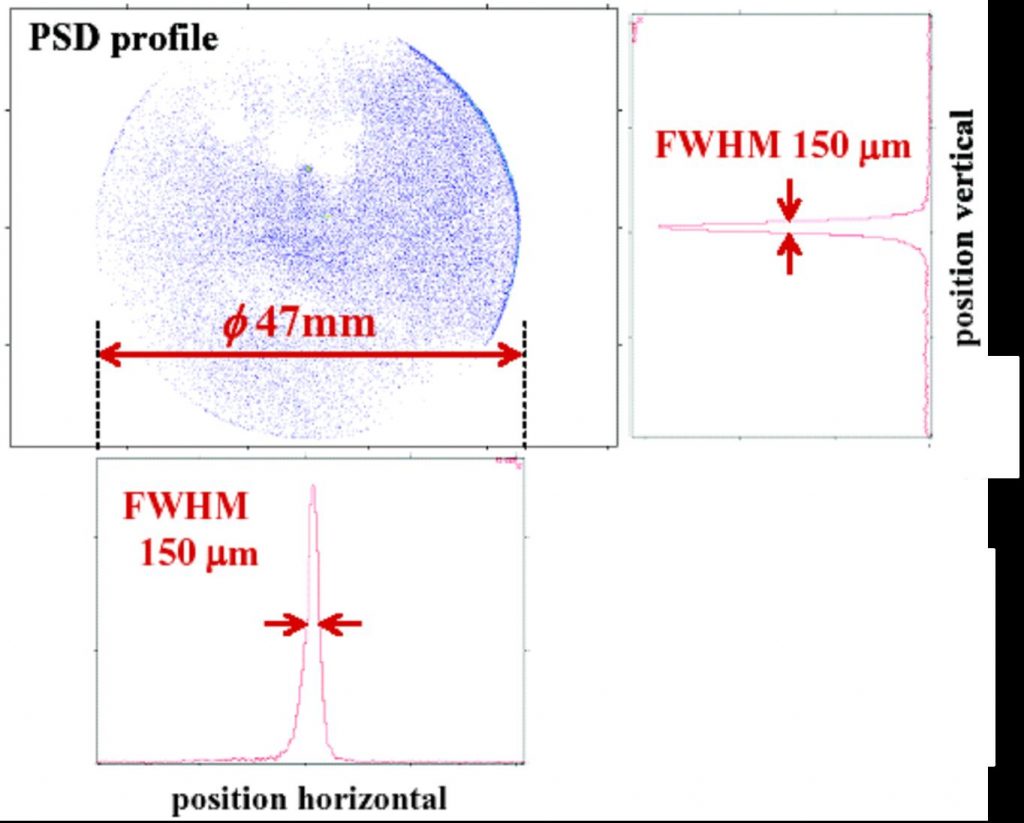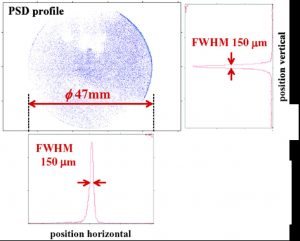A.Cassimi, L.Maunoury, T.Muranaka, H.Lebius, B.Manil, B.Huber DSM/DRECAM et GANIL / CIRIL
Centre Interdisciplinaire de Recherche Ions Laser,
T. Ikeda et Y. Yamazaki, Atomic Physics Laboratory, RIKEN, Japan
Obtaining highly charged beams with diameter lower than one micron is not a recent objective and several solutions were considered and tested. The realization of a beam of so reduced size already excluded a focusing by electrostatic or magnetic lenses because of the poor optical qualities of the ion sources (flux density or energy dispersion). However, collimation by one (or several) diaphragm makes it possible to achieve the required result but at the price of a drastic reduction of the flow of particles. Lastly, the idea of a “funnel”, if it seems at first obvious, requests to solve the problem of the necessary interaction of the ions with the walls.
The selected process comes from a series of successive discoveries. At the origin, is the effect, known as “trampoline”, highlighted by a French team on an insulating surface [1]: the capture of electrons by the incidental ion leaves localized electric charges on the surface. The resulting Coulomb repulsion slows down, until if required reflecting, the incidental ion. One very surprising second discovered [2] is the observation by a team of the Hahn-Meitner-Institute of Berlin of the transmission of a Ne7+ beam through a network of pores (100 nm diameter, 10 µm length) carried out in a polymer sheet (FART): whereas one could expect that the surface of the walls of the pores becoming charged, passage of the ions becomes prohibited. On the opposite, the charged channels support guidance and stop the later charge exchanges. After passing the pores, the initial charge number of the ions is preserved at the exit, even for a 15° incidence.
All the ideas were there to suggest the idea of an insulating tube to focus an ion beam. Pr. Y.Yamazaki (RIKEN, Japan) and its team, members of the collaboration, have first proposed the use of borosilicate capillaries [3]. Hot stretched over a length of several centimeters, the capillary can be worked to obtain a cone with a 2mm diameter input and less than 1 µm at the exit. However it remains to check that highly charged ions could leave such a “micro-funnel” without modification of its charge number.
The transmission of an Ar8+ beam and more recently of a Xe23+ one, with energies of a few keV, obtained jointly at RIKEN (Japan) and CIRIL (Caen), proves the feasibility of the process. This appears to be possible by the auto-organized electric loading of the walls of the micrometric insulating tube. In addition, the first experiments show that the transmission remains stable over several hours and is not a transitory phenomenon to be related to the progressive loading of the walls. The increase by one order of magnitude of the beam current density shows finally that the capillary plays an active part, beyond the simple focusing of the beam. It was thus possible to obtain a beam (Ar8+ at 80 keV) with an initial diameter of about 1 µm (size of the capillary exit). Its divergence is lower than 0.4 milliradian (150 µm diameter at 20 cm of the capillary exit, see figure).
The system already works and is thus applicable to the production of micrometric beams. Remains to be better experimentally and theoretically understood, the finest details of the ion-surface interaction for the selected geometry. Finally, the optical quality of the beam at the exit of capillary would allow additional focusing by more conventional means (electromagnetic lenses) to further decrease the beam size in the nanometric range.

References :
[1] Observation of hollow atoms or ions above insulator and metal surfaces,
J.-P. Briand, S. Thuriez, G. Giardino, G. Borsoni, M. Froment, M. Eddrief, and C. Sébenne, Phys. Rev.Lett. 77, 1452 (1996)
[2] Transmission of 3 KeV Ne7+ Ions through Nanocapillaries Etched in Polymer Foils: evidence for Capillary Guiding, N. Stolterfoht, J.-H. Bremer, V. Hoffmann, R. Hellhammer, D. Fink, A. Petrov, and B. Sulik, Phys. Rev.Lett. 88, 133201 (2002)
[3] Production of a microbeam of slow highly charged ions with a tapered glass capillary
T.Ikeda et al, Applied Phys.Lett. 89, 163502 (2006).
[4] A. Cassimi, Y.Yamazaki et al., à paraître dans Int.Jour.Nanotechnology (IJNT) (2007).


